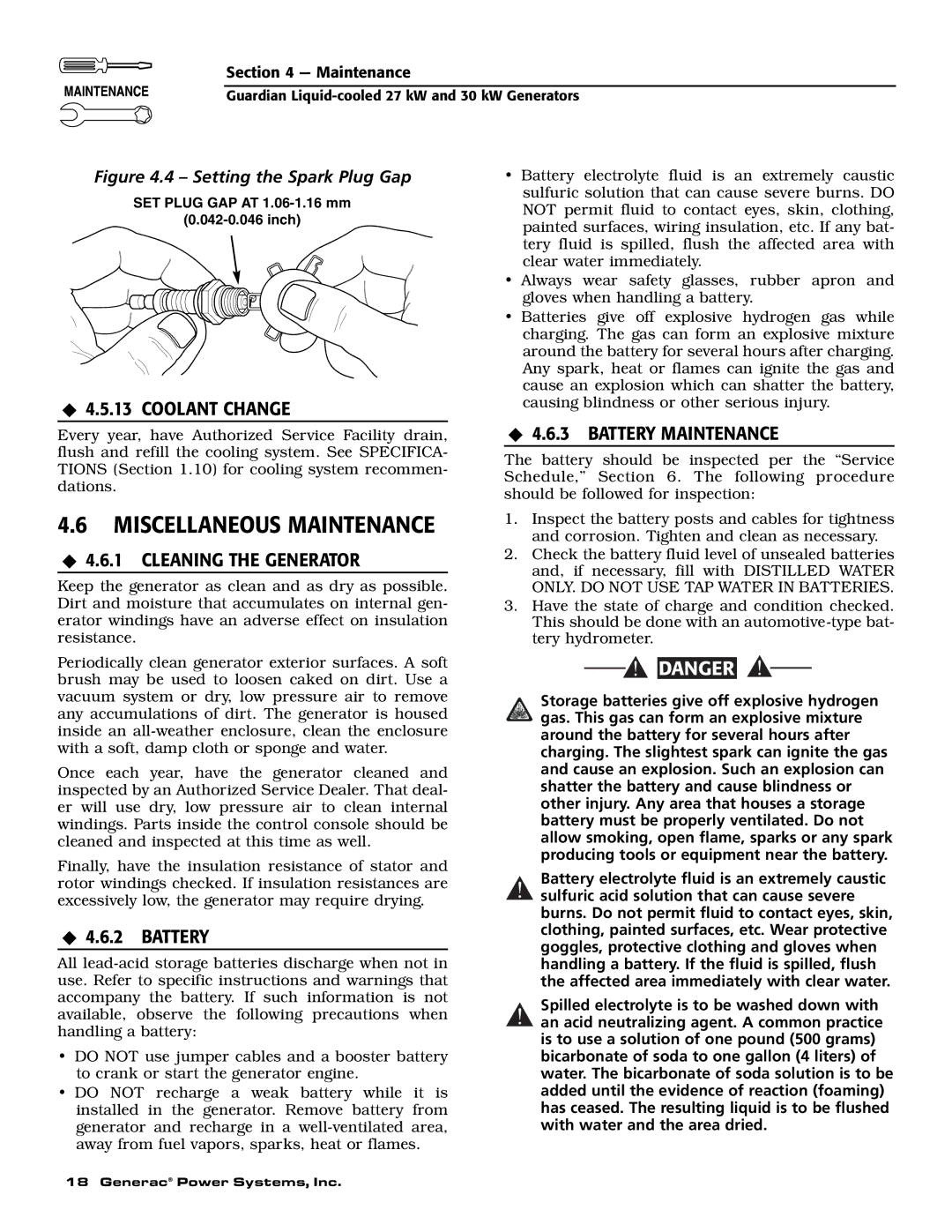
Section 4 — Maintenance
Guardian
Figure 4.4 – Setting the Spark Plug Gap
SET PLUG GAP AT |
4.5.13 COOLANT CHANGE
Every year, have Authorized Service Facility drain, flush and refill the cooling system. See SPECIFICA- TIONS (Section 1.10) for cooling system recommen- dations.
4.6MISCELLANEOUS MAINTENANCE
4.6.1 CLEANING THE GENERATOR
Keep the generator as clean and as dry as possible. Dirt and moisture that accumulates on internal gen- erator windings have an adverse effect on insulation resistance.
Periodically clean generator exterior surfaces. A soft brush may be used to loosen caked on dirt. Use a vacuum system or dry, low pressure air to remove any accumulations of dirt. The generator is housed inside an
Once each year, have the generator cleaned and inspected by an Authorized Service Dealer. That deal- er will use dry, low pressure air to clean internal windings. Parts inside the control console should be cleaned and inspected at this time as well.
Finally, have the insulation resistance of stator and rotor windings checked. If insulation resistances are excessively low, the generator may require drying.
4.6.2 BATTERY
All
•DO NOT use jumper cables and a booster battery to crank or start the generator engine.
•DO NOT recharge a weak battery while it is installed in the generator. Remove battery from generator and recharge in a
•Battery electrolyte fluid is an extremely caustic sulfuric solution that can cause severe burns. DO NOT permit fluid to contact eyes, skin, clothing, painted surfaces, wiring insulation, etc. If any bat- tery fluid is spilled, flush the affected area with clear water immediately.
•Always wear safety glasses, rubber apron and gloves when handling a battery.
•Batteries give off explosive hydrogen gas while charging. The gas can form an explosive mixture around the battery for several hours after charging. Any spark, heat or flames can ignite the gas and cause an explosion which can shatter the battery, causing blindness or other serious injury.
4.6.3 BATTERY MAINTENANCE
The battery should be inspected per the “Service Schedule,” Section 6. The following procedure should be followed for inspection:
1.Inspect the battery posts and cables for tightness and corrosion. Tighten and clean as necessary.
2.Check the battery fluid level of unsealed batteries and, if necessary, fill with DISTILLED WATER ONLY. DO NOT USE TAP WATER IN BATTERIES.
3.Have the state of charge and condition checked. This should be done with an
![]()
![]() DANGER
DANGER
Storage batteries give off explosive hydrogen gas. This gas can form an explosive mixture around the battery for several hours after charging. The slightest spark can ignite the gas and cause an explosion. Such an explosion can shatter the battery and cause blindness or other injury. Any area that houses a storage battery must be properly ventilated. Do not allow smoking, open flame, sparks or any spark producing tools or equipment near the battery.
Battery electrolyte fluid is an extremely caustic ! sulfuric acid solution that can cause severe
burns. Do not permit fluid to contact eyes, skin, clothing, painted surfaces, etc. Wear protective goggles, protective clothing and gloves when handling a battery. If the fluid is spilled, flush the affected area immediately with clear water.
Spilled electrolyte is to be washed down with ! an acid neutralizing agent. A common practice is to use a solution of one pound (500 grams) bicarbonate of soda to one gallon (4 liters) of
water. The bicarbonate of soda solution is to be added until the evidence of reaction (foaming) has ceased. The resulting liquid is to be flushed with water and the area dried.
18 Generac® Power Systems, Inc.
